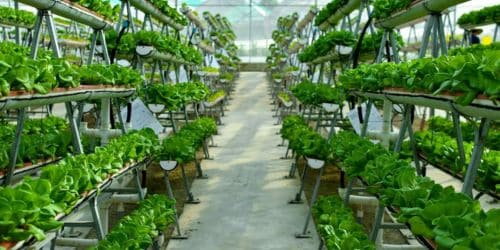We can no longer feed the growing population. With dwindling water and land resources over the next three decades, feeding the world’s 10 billion people will become more difficult. We must employ more effective cultivation techniques if we are to succeed in feeding the world. One of the most promising ways to do this is to implement indoor vertical farming. Consider your company’s requirements, location, target market, and available funding when selecting the ideal vertical farming system for your farm. Here are the top vertical farming businesses that are revolutionizing food production with locations all over the United States.
In contrast to conventional, horizontal agriculture, vertical farming involves cultivating crops on vertical surfaces. Farmers can grow significantly more food on the same amount of land by using layers that are vertically stacked.
Frequently, these layers are incorporated into structures like skyscrapers, kept in storage facilities or shipping containers, grown in greenhouse. They are alsoor positioned in areas that would not normally be suitable for farming.
Vertical farming, however, involves much more than just piling up plants and hoping for the best. The procedure calls for controlled artificial lighting, humidity, water, and temperature. A whole crop could be lost if a delicate balance is not kept, just as a traditional farm might in the event of a drought or flood.
Vertical Farming
Growing crops and plants vertically on multiple-level racks inside climate-controlled structures is known as vertical farming. Each rack has an area above it where plants can climb. Contrary to using farmland or conventional greenhouses, these high-tech farms significantly reduce the amount of space required to grow food. This is because they can be housed in warehouses, industrial buildings, or even skyscrapers. Although many other crops can be successfully grown vertically, leafy greens, herbs, and microgreens are typically the best options. In some vertical farms, different kinds of fruits, flowers, grains like rice, and vegetables are grown.
Vertical farming using controlled-environment agriculture
Vertical farms are fully automated indoor spaces built on the technology of controlled-environment agriculture (CEA). This guarantees that the crops develop in the ideal microclimate, allowing for high yields all year long. Contrary to conventional agriculture, harvest cycles are much quicker, and yields are predictable. Uncertainties like floods and droughts, which are impossible to forecast in outdoor agriculture, are not included in CEA. Growing in areas where the environmental conditions can be adjusted to suit the requirements of particular plants is what is meant by the term “CEA” farming. In today’s intelligent farms, various parts of a single farm may have varying levels of humidity, temperature, light, and nutrients. This means that various plants can grow in a single indoor farm with environments that are tailored to their specific requirements.
The ecosystem of a vertical farm is controlled by CEA technology to ensure that the plants are kept in the best possible conditions:
- Lighting
- Temperature
- Climate control
- Watering
- Nutrition
Types of Vertical Farming Systems
The three most popular indoor vertical farming techniques are hydroponics, aeroponics, and aquaponics. To provide plants with wholesome nutrition, they all employ soilless cultivation techniques.
#1. Aquaponic Vertical Farming
Aquaponic vertical farming combines the raising of fish with the hydroponic growing of plants. Aquaponics, then, is the practice of growing fish and vegetables together. A pump system in this procedure collects, filter, and add necessary elements to the wastewater from fish tanks. Then, this water is circulated up to the plants located above the fish unit. The plants then use this water to oxygenate it while obtaining all the necessary nutrients. It is then pumped back into the fish tank after that.
Aquaponic farming is a “win-win” situation because the fish receive water with a high oxygen content while the greens get everything they require for healthy growth. Aquaponic farms also do not require a lot of space because the plant trays are placed above the fish unit, which is another benefit. Aquaponics functions as a self-contained cycle, so if one part fails, the entire system fails. The biggest drawback of this vertical farming system is this. Due to its complexity, aquaponic farming is more expensive to set up and grow than hydroponic or even aeroponic farming.
#2. Aeroponic Vertical Farming
Aeroponics enables soil-free plant growth, just like hydroponics and aquaponics. Here, the farmers immerse the plants in these farms in a solution of nutrient-rich mist. In an aeroponic vertical farm, it might initially seem as though the plants are just hovering. However, the procedure is much more complicated.
They grow the vegetation on foam, and a mesh lid allows the roots to enter the fog chamber. Then spray a nutrient-rich solution on the roots, giving the plants food. Furthermore, they connect a timer to the pump to ensure that the roots receive consistent water and nutrients.
In contrast to hydroponics, which involves purchasing nutrients and adding them to the water supply, aeroponics has the drawback of being expensive to set up and requiring specialized equipment.
#3. Hydroponic Vertical Farming
Due to its superior market efficiency hydroponics is the most effective vertical farming system and adaptability. It may be applied in both commercial and retail settings. In comparison to aeroponics, hydroponics allows for the cultivation of a wider range of crops and has significantly lower initial costs. As opposed to aquaponics, where farmers grow fish and crops together, there is less complication in this system. Running a hydroponic vertical farm presents several challenges, including choosing the appropriate level of automation to lower costs and avoid production risks.
Plant roots in hydroponic systems are immersed in substrates like perlite and rock wool, typically with the help of a nutrient-rich water solution. Hydroponic farming systems use different methods of growing plants in artificial environments, including wick, drip, flooding, and nutrient layering.
The Benefits of Vertical Farming
With this model, you can maximize output while minimizing your impact on the environment and using a lot less space. Vertical farming has many advantages. It will become more challenging to maintain food production using conventional techniques as resources become scarcer.
#1. Reduce Your Use of Space & Water
The use of 99 percent less land and 98 percent less water is possible for farmers using vertical farming techniques. They can roll or perpetually harvest crops all year long, resulting in crop yields that are 240 times greater than those of conventional farms. We do not use LED lights or other less-than-ideal energy sources to power any of our crops; instead, the sun powers all of our produce. Vertical farming provides a way to meet this increased need for food without the need for large fields in these densely populated urban areas.
#2. Increased Production All Year
Additionally, the production from vertical farming is more consistent throughout the year and has increased overall output. Some fruits and vegetables are now year-round commodities, unlike in the past. Vertical farms, on the other hand, can grow a wide variety of crops all year long with little reliance on the weather or climate.
#3. Remedy for Food Desert
Last but not least, vertical farms can help alleviate the growing issue of food deserts in densely populated areas where there is a lack of access to fresh foods like fruits and vegetables.
Where food deserts once existed, vertical farming has already begun to create food oases because it can be built with a small environmental impact and even integrated into existing structures and rooftops.
This fills the gap where previously there were only unhealthy food options. It can also produce inexpensive and nutrient-dense food for low-income families because it does not call for a protracted shipping and warehousing process.
#4. Reduced Emissions
Because vertical farms can be constructed in urban areas, less produce must travel as a result of farms and supermarkets having closer proximity, which lessens the carbon footprint of the industry. As a result, your local grocery store will receive fresher produce and fewer food miles. Food grows just a few miles from the point of consumption keeping its freshness longer, reducing food waste, and providing fresher, healthier food for local families.
Vertical Farming Company
#1. Bowery Farming
Since 2015, Bowery Farming has been utilizing indoor vertical farming to produce what it claims to be more dependable and environmentally friendly crops. The company’s operating system uses artificial intelligence to track each crop and notify farmers when it is time to harvest. Bowery produces a variety of fruits and vegetables, including strawberries, lettuce, and other greens, and sells them at Walmart, Safeway, and Amazon. They have three vertical farms in New Jersey, Maryland, and Pennsylvania. It uses vertical farming to cultivate a wide variety of pesticide-free fruits, vegetables, and leafy greens like kale, lettuce, and basil and has a sizable customer base throughout the United States. To grow tomatoes, strawberries, cucumbers, and root vegetables, the company has its breeding program and research facility.
#2. CubicFarms
When farmers Jack Benne and his son Leo Benne decided to create indoor growing technologies to grow fresh produce with the least amount of negative environmental impact in 2008, the company was born. For instance, the HydroGreen Grow System can generate up to 25 million pounds (11.3 million kilograms) of fresh livestock feed annually while utilizing one-tenth of the water needed to produce conventional livestock feed grown in irrigated fields. They were able to provide one glass of fresh water to every person on the planet thanks to their annual savings of more than 500 million gallons (1.8 billion liters) of water. The Canadian business also uses between 54% and 62% less energy than conventional vertical farms because it moves the plants to follow the light rather than providing individual lighting for each one.
#3. AeroFarms
Since 2004, AeroFarms has been putting the most recent developments in plant biology, artificial intelligence, and indoor vertical farming to use to improve the production and distribution of fresh produce both locally and internationally as well as to fix our broken food system. The world’s largest vertical farm for research and development by AeroFarms, is a leader in the industry. The award was given at the first-ever Global SDG Awards, which recognize private-sector leadership in advancing the UN 2030 Agenda. To sell its leafy greens, which range from baby bok choy and arugula to spinach and micro broccoli, the company collaborated with US retail behemoths Whole Foods and Walmart, among others.
The first B Corporation-certified indoor vertical farming business, AeroFarms has created an aeroponic technology to give plants the best possible environment. It is an indoor agriculture business with headquarters in Newark, New Jersey, that produces a range of vegetables using a patented aeroponic system.
#4. Altius Farms, Inc
Altius Farms supplies a wide range of premium herbs and leafy greens locally all year round across the United States using patented, vertical growing technology. One of the biggest and highest-elevation aeroponic vertical farms in the US was constructed by Altius Farms. Additionally, it provides veterans and urban youths with on-site training.
Leading products from Altius Farms include specialty blends like Brassica Blend, Urban Farmer Blend, and Spring Blend, herbs like Genovese Basil, specialty greens, and lettuce.
#5. Freight Farms
Freight Farms produces hydroponic shipping containers that enable people to grow food year-round and has a network of more than 600 farmers in countries all over the world. In addition to offering events, video guides, and an agricultural system that includes lettuce, herbs, edible flowers, and roots, Freight Farms also helps people on their path to vertical farming. 41 nations and 49 U.S. states and territories have Freight Farms containers available for purchase.
#6. InFarm
One of the biggest vertical farming businesses in Europe, InFarm was established in Berlin in 2013 by Osnat Michaeli, the brothers Erez and Guy Galonska, and Osnat Michaeli. The business employs cloud farming, a cutting-edge method that involves a network of large-scale, self-teaching growing facilities that continuously enhance plant yield, flavor, and nutritional value while using fewer natural resources. With more than 1,200 farms in stores and distribution facilities, InFarm has partnered with more than 30 major food retailers, including Canadian Aldi Süd, German Kaufland, and Edeka, as well as Amazon Fresh, Marks & Spencer, and Whole Foods Market in Canada, Denmark, France, Germany, Japan, Luxembourg, the Netherlands, the United Kingdom, the United States, and Switzerland.
#7. iFarm
The distinguished iFarm, established in 2017 in Helsinki, Finland, is last but certainly not least on our list of vertical farming businesses. iFarm-built vertical farms use 90% less water, 75% less fertilizer, and no pesticides than conventional farms. By maximizing technology and lowering the “human factor” and labor costs, they also save enormous amounts of energy. All of this makes it possible to grow crops all year long efficiently and sustainably. They sell products from iFarm all over the world, from Switzerland and France to Saudi Arabia and India, including leafy greens, various kinds of vegetables, and fruit like strawberries
What Is the Vertical Farming Method?
A cutting-edge technique called “vertical farming” involves artificially stacking plants vertically on top of one another, either in skyscrapers or by utilizing the third dimension of space. This could assist in resolving several issues that could arise in the future, including food shortage and malnutrition as well as contaminated food.
Farmers grow crops by stacking them vertically in a process called “vertical farming.” It frequently uses soilless farming methods like hydroponics, aquaponics, and aeroponics as well as controlled-environment agriculture, which seeks to maximize plant growth.
What Is the Best Vertical Farming Method?
The three main types of systems used in vertical farming are hydroponic, aquaponic, and growing-media-based systems. Hydroponics is one of the earliest and most popular types of vertical farming, and it entails growing plants in nutrient-rich water rather than soil.
Where Is the Largest Vertical Farm?
In Newark, New Jersey, a New York start-up company called AeroFarms has constructed the biggest vertical farm in the world. A former steel factory houses the farm’s 69,000 square feet, according to a report by Global Citizen. They grow 250 different varieties of greens and herbs in plant beds of 12 stack layers high.
The location of over 330,000 square-foot building is at Dubai World Central, close to Al Maktoum International Airport in Dubai, United Arab Emirates. It produces a year’s worth of leafy greens there for over 2 million pounds. The hydroponic facility, which can grow more than 1 million plants at once and produce 3,000 kg per day, is at Dubai World Central, close to Al Maktoum International Airport. They use the facility’s leafy greens to prepare meals for Emirates and other airlines’ passengers.
What Is the Most Common Vertical Farming?
The most popular vertical farming method is hydroponics. The plants in this situation have their roots grown in a water-based nutrient solution. Farmers use a water pump to continuously move the solution, after mixing it with nutrients.
Farmers monitor temperature, salinity, and nutrient levels regularly to ensure they meet the needs of the system’s plants.
What Is the Difference Between Vertical Farming and Hydroponics?
When compared to hydroponic farming, vertical farming emphasizes growing plants on sloped surfaces or in stacked layers. Urban settings can accommodate both. Systems are even more effective and productive by combining hydroponics and vertical farming
Uses of Sensors in Vertical Farming?
Smart sensors in vertical farms keep an eye on a variety of technical factors, including temperature, CO2, oxygen, lighting, humidity, nutrient concentration, pH, pest control, irrigation, and harvesting. In controlled environments, cultivation methods like hydroponics, aeroponics, or aquatic are frequently used. In addition, controlled environment agriculture can make use of sophisticated imaging and sensor technologies, such as cameras and thermal imaging, to measure plant growth, temperature, and other variables.
Conclusion
Many people think that a sizable part of the future of agriculture may include vertical farming. With the development of AgTech, farms are becoming more high-tech, allowing farmers to produce more, pollute less, and address the challenges we face going forward.
The technology used in vertical farms will probably advance as well. This could lead to a variety of outcomes, including robotic harvesting and monitoring, AI-powered CEA systems, and much more. As we work to overcome the challenges at hand, one thing is clear: vertical farms will probably become much more typical.
Related Articles
- BUSINESS FARMING: Profitable Ideas on How to Start a Small Farm Business
- FARM EQUIPMENT: Types Of Farm Equipment And Their Uses
- HOW TO START A FARM: Step-To-Step Guide to Farming Success






